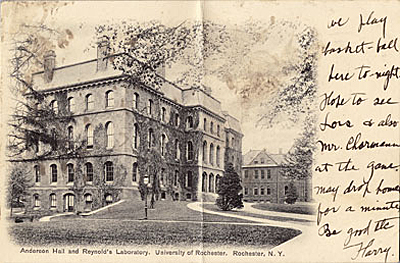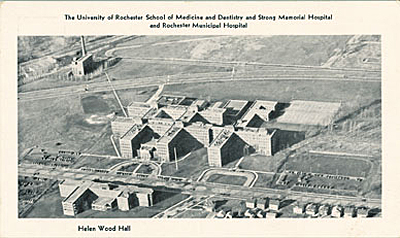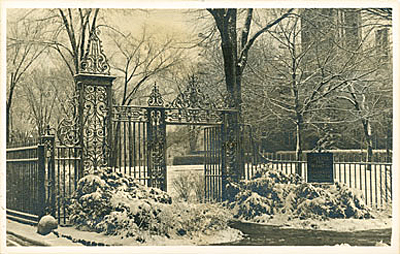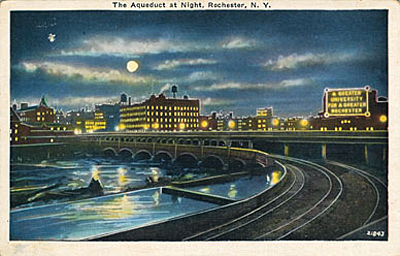Features
 PRINCE STREET: A panoramic view of the Prince Street Campus shows (left to right) Sibley, Anderson, and Reynolds halls. Just visible to the right of Reynolds is a small dome which was an observatory that housed a telescope with a six-inch object glass. The observatory and telescope were gifts of John Trevor, then president of the University’s Board of Trustees (Photo: Courtesy of Mark Zaid ’89 and University Libraries).
PRINCE STREET: A panoramic view of the Prince Street Campus shows (left to right) Sibley, Anderson, and Reynolds halls. Just visible to the right of Reynolds is a small dome which was an observatory that housed a telescope with a six-inch object glass. The observatory and telescope were gifts of John Trevor, then president of the University’s Board of Trustees (Photo: Courtesy of Mark Zaid ’89 and University Libraries).Take a walk around the River Campus in 2009, and you’re sure to find students “texting,” e-mailing, and “Twittering” away on cell phones, laptops, iPhones, and BlackBerries.
A century ago, Rochester students had the same kinds of simple messages, but they had a different state-of-the-art means for delivering them: the postcard.
 SIBLEY HALL: The second building on the Prince Street Campus, Sibley Hall opened in 1877 and served as the University library until 1930, when the College for Men moved to the River Campus. A gift from Rochester businessman Hiram Sibley, founder of the Western Union Telegraph Co., the building housed the library for the College for Women until 1955, when the women, too, left for the River Campus (Photo: Courtesy of Mark Zaid ’89 and University Libraries).
SIBLEY HALL: The second building on the Prince Street Campus, Sibley Hall opened in 1877 and served as the University library until 1930, when the College for Men moved to the River Campus. A gift from Rochester businessman Hiram Sibley, founder of the Western Union Telegraph Co., the building housed the library for the College for Women until 1955, when the women, too, left for the River Campus (Photo: Courtesy of Mark Zaid ’89 and University Libraries). ANDERSON HALL: Opened in 1861 as the first building on the Prince Street Campus, Anderson Hall remained a part of the University until 1955 when the women students moved to the River Campus. Named for the University’s first president, Martin Anderson, the building contained a chapel, lecture rooms, administrative offices, a library, and a basement apartment for the janitor. The postcard was sent to an address in Rochester and reads in part: “We play basket-ball here to-night . . . May drop home for a minute. Be good etc. Harry.” (Photo: Courtesy of Mark Zaid ’89 and University Libraries).
ANDERSON HALL: Opened in 1861 as the first building on the Prince Street Campus, Anderson Hall remained a part of the University until 1955 when the women students moved to the River Campus. Named for the University’s first president, Martin Anderson, the building contained a chapel, lecture rooms, administrative offices, a library, and a basement apartment for the janitor. The postcard was sent to an address in Rochester and reads in part: “We play basket-ball here to-night . . . May drop home for a minute. Be good etc. Harry.” (Photo: Courtesy of Mark Zaid ’89 and University Libraries). EASTMAN THEATRE: With the words “For the Enrichment of Community Life” engraved on its façade, Eastman Theatre opened in 1922. Eastman Kodak founder and University benefactor George Eastman attended the theater regularly, and his favorite chair, Number 48, in the front row of the mezzanine, was reserved for him at all performances (Photo: Courtesy of Mark Zaid ’89 and University Libraries).
EASTMAN THEATRE: With the words “For the Enrichment of Community Life” engraved on its façade, Eastman Theatre opened in 1922. Eastman Kodak founder and University benefactor George Eastman attended the theater regularly, and his favorite chair, Number 48, in the front row of the mezzanine, was reserved for him at all performances (Photo: Courtesy of Mark Zaid ’89 and University Libraries). SCHOOL OF MEDICINE & DENTISTRY: Based on the “Flexner Model” of aligning medical schools with teaching hospitals—in Rochester’s case, Strong Memorial Hospital—the School of Medicine and Dentistry opened in 1925. Note the heating plant at the upper left. First fired up in 1924, the plant was to heat both the Medical Center and the yet-to-be-built River Campus (Photo: Courtesy of Mark Zaid ’89 and University Libraries).
SCHOOL OF MEDICINE & DENTISTRY: Based on the “Flexner Model” of aligning medical schools with teaching hospitals—in Rochester’s case, Strong Memorial Hospital—the School of Medicine and Dentistry opened in 1925. Note the heating plant at the upper left. First fired up in 1924, the plant was to heat both the Medical Center and the yet-to-be-built River Campus (Photo: Courtesy of Mark Zaid ’89 and University Libraries). CAMPUS CLUBHOUSE: The clubhouse of the original Oak Hill Country Club was used as an office to help oversee the construction of the River Campus in the late 1920s. Founded in 1901 on a former farm in a bend of the Genesee River, the Oak Hill golf club sold the land to the University and moved to its current location in nearby Pittsford, N.Y., to make way for the River Campus. The clubhouse burned down in 1929 (Photo: Courtesy of Mark Zaid ’89 and University Libraries).
CAMPUS CLUBHOUSE: The clubhouse of the original Oak Hill Country Club was used as an office to help oversee the construction of the River Campus in the late 1920s. Founded in 1901 on a former farm in a bend of the Genesee River, the Oak Hill golf club sold the land to the University and moved to its current location in nearby Pittsford, N.Y., to make way for the River Campus. The clubhouse burned down in 1929 (Photo: Courtesy of Mark Zaid ’89 and University Libraries). CUTLER UNION: Now part of the Memorial Art Gallery, Cutler Union opened in 1933 as part of an effort to improve amenities on the Prince Street Campus, which by that time was home to the College for Women. Named for James Cutler, the City of Rochester’s mayor from 1904 to 1908, and a benefactor and trustee of the University, the building served as a student union with a cafeteria in the basement and dormitory space on the upper floors (Photo: Courtesy of Mark Zaid ’89 and University Libraries).
CUTLER UNION: Now part of the Memorial Art Gallery, Cutler Union opened in 1933 as part of an effort to improve amenities on the Prince Street Campus, which by that time was home to the College for Women. Named for James Cutler, the City of Rochester’s mayor from 1904 to 1908, and a benefactor and trustee of the University, the building served as a student union with a cafeteria in the basement and dormitory space on the upper floors (Photo: Courtesy of Mark Zaid ’89 and University Libraries). SEASONAL SCENES: Rochester’s wintry weather was rarely reflected in the University’s postcards. Built in 1933 on University Avenue to welcome visitors to the College for Women, the wrought iron gates no longer stand (Photo: Courtesy of Mark Zaid ’89 and University Libraries).
SEASONAL SCENES: Rochester’s wintry weather was rarely reflected in the University’s postcards. Built in 1933 on University Avenue to welcome visitors to the College for Women, the wrought iron gates no longer stand (Photo: Courtesy of Mark Zaid ’89 and University Libraries). ‘A GREATER ROCHESTER’: As early as 1920, University officials recognized that plans for expansion would require a new campus. Titled “The Aqueduct at Night,” a 1924 postcard of Broad Street and the former Erie Canal aqueduct in downtown Rochester showcases a neon sign bearing the slogan, “A Greater University for a Greater Rochester.” The sign was part of a 1924 campaign that sought to raise $10 million dollars in 10 days to fund the construction of the River Campus (Photo: Courtesy of Mark Zaid ’89 and University Libraries).
‘A GREATER ROCHESTER’: As early as 1920, University officials recognized that plans for expansion would require a new campus. Titled “The Aqueduct at Night,” a 1924 postcard of Broad Street and the former Erie Canal aqueduct in downtown Rochester showcases a neon sign bearing the slogan, “A Greater University for a Greater Rochester.” The sign was part of a 1924 campaign that sought to raise $10 million dollars in 10 days to fund the construction of the River Campus (Photo: Courtesy of Mark Zaid ’89 and University Libraries).While that period—the turn of the 20th century—is considered the “golden age” of the postcard, as anyone who has stopped by a gift shop knows, postcards are alive and well, coexisting as a medium message alongside their more modern counterparts.
Mark Zaid ’89, a prominent Washington, D.C., attorney and avid collector, has been amassing cards depicting the University since he was a student. During Meliora Weekend 2004, he was struck with an idea: He proposed to Richard Peek, director of Rare Books and Special Collections, Nancy Ehrich Martin ’65, ’94 (MA), the John M. and Barbara Keil University Archivist, and Karl Kabelac, University archivist emeritus, that they collaborate on a book in which cards—Zaid’s as well as the Libraries’—would help tell the story of the University, particularly the period from 1904 to the present.
With more than 200 cards to choose from, Zaid was confident the collection would provide a unique view of Rochester’s progression from a small college along Prince Street to a major research university on the banks of the Genesee River.
“It’s amazing how much history of the school is shown in these cards,” he says.
After four years of research, Zaid, Martin, Kabelac, and digital librarian Melissa Mead finished the project this spring. Wish You Were Here, a glossy book available in both hardcover and softcover, features over 50 pages of postcards spanning more than a century.
To order a copy, visit the Web site of Rush Rhees Library. All profits will be donated to Rush Rhees Library Rare Books and Special Collections.
